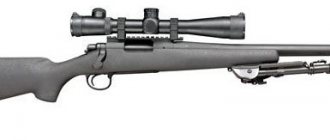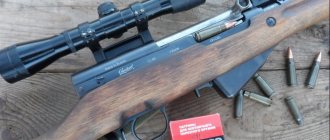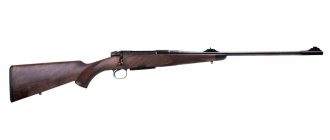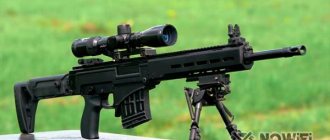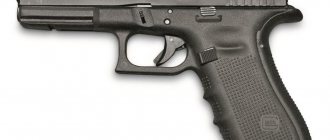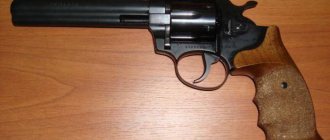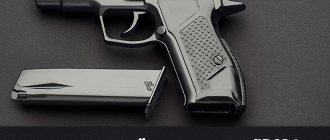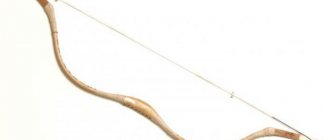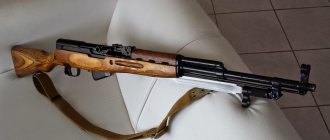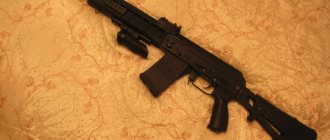Long and well-known hunting carbines of the horizontal and tee type, widespread in the last decades of the nineteenth and early twentieth centuries from the Heim company in Europe and Russia. It was they who became the prototype and designation of the reliability, quality factor, quality and reliability of small arms of civilian weapons. Despite the fact that the middle of the last century, in particular the period after the end of World War II, became a rather dangerous time of crisis for the company, which lasted quite a long time, the management managed to do the almost impossible.
Thus, German gunsmiths managed to maintain the status of the brand. The brand remained among the leaders in the world-class arms industry in Germany and European countries. The Heim rifle is a highly competitive rifle these days, being a worthy opponent to well-known weapons manufacturers in Europe, the USA, and Russia. Real, fair competition has allowed the company not only to produce excellent hunting weapons, to monitor world-class trends, and to quickly respond to current fluctuations in market demand.
Review of the Heym SR-21 carbine
A true world-class leader, as always, is distinguished by a truly German approach to literally every detail. A distinctive feature of the Haym SR-21 carbine, as always, is the refined charm of modesty and the elaboration of every detail from the shape of the butt to the trigger mechanism.
In addition, the manufacturer is famous for the exceptional quality of materials and a very reasonable price. The weapon is distinguished by its conservative technological solutions, which is fundamentally the leading priority for the buyer.
Commitment to tradition was also reflected in the main trend - the Heim company did not reduce the cost of the design through lightweight alloys or plastic.
This video contains a review of the Heym SR-21 carbine:
Advantages and disadvantages
Fans of hunting and lovers of sports clay shooting note a lot of advantages of the weapon - excellent external design, a high-quality bolt mechanism, a well-designed barrel, an open sight system, excellent German optics, three safety positions.
Users consider the following disadvantages:
- somewhat high price
- not very convenient rear optics mounting system
- and the presence of a dovetail rotor.
Purpose
An exclusively hunting weapon for almost all types of living creatures living in the vast expanses of our fatherland. Practical Germans adapted their carbine perfectly to the needs of our hunters and lovers of traveling through forests, meadows and swamps.
The new Heym SR-21 has been given all the best performance properties, as they say - it hits everything that is allowed under the law, from a goose to a moose and a bear.
Heym SR-21 carbine
Varieties
The manufacturer of the Heim SR-21 hunting carbine in configuration N is offered to customers in three types of barrel calibers:
- The most popular caliber is 9.3 x 62 mm.
- Export version 30 – 06 spr.
- The largest caliber is 223 rem.
In short, we can say that a Russian buyer can purchase a range of calibers - 243 Winchester, . 308 Winchester, . 30–06 Springfield, 9, 30 x 62, . 300 Winchester Magnum, 8 x 68 S. For some reason, mass dealers were not interested in . 25 - 06, 7 x 64, 6 x 62, but they are available for individual order from the Heim campaign.
MAKSIMOV.SU
Yuri Maksimov
photo by the author
Classic hunting rifles made of steel and walnut are a special song that warms the soul of any connoisseur of good weapons.
Even under the conditions of sanctions, a wide variety of “miscellaneous things” is presented on the shelves of Russian weapons stores. But German weapons have always been and will be spiritually closer to us. This is how it happened historically. In addition, the Germans know how to work with metal and wood, this cannot be taken away from them.
In contrast
European hunting shotguns and rifles have always been distinguished from American weapons by a more traditional appearance and sophisticated technical solutions. But nowadays the desire for certain innovations that are dictated by the market is in fashion.
And sometimes
everything can be explained simply: someone came up with something really successful and immediately everyone rushed into the same niche with their products. Haste and the desire to “skim off the cream” usually cause the appearance of insufficiently well-developed designs.
Rifle HEYM SR-30
is the result of modern marketing. This is an example of an attempt to take its place in the sun next to the Blazer upright vehicles. This is an interesting combination of classics and new technical solutions, which never received the desired development.
A little history
Arms firm Friedrich Wilhelm Heym
is one of the most prestigious German companies. At least that’s what we think in Russia. In Germany itself, Heym is an ordinary arms company. At least that's what its competitors think.
Think,
owners of “Heims” both here and in Europe can independently determine the level of prestige of their shotguns and rifles. Personally, I like Heym weapons for their originality, workmanship and technical sophistication.
Buttstock with a classic “boar back”
a Bavarian cheekpiece , no less traditional for German hunting rifles
Friedrich Wilhelm Heim
founded his factory in Suhl in July 1865. In the early 1890s. Heim created the world's first hammerless tee. This was the main event that influenced the future fate of the company. After the reorganization of production, this company began producing hammerless rifles and combination guns.
Efficient rubber shock absorber
This gave results
- German hunting weapons gained worldwide fame. In Russian pre-revolutionary catalogs, FriedrichWilhelmHeymGewehr-Fabrik weapons occupied a worthy place and enjoyed deserved popularity among the Russian hunting elite.
To date
Heym specializes in the production of prestigious high-quality weapons, including combination shotguns and "African" rifles. According to this manufacturer, most of the fittings used in Africa are made in the workshops of the Heym plant.
SR-30 bolt group, rear view.
The massive shutter clutch is clearly visible
Company representatives
position their weapons only in the form of the slogan “German quality. English style". The combination of a large share of manual labor, high quality, more than 150 years of history and competent marketing policy - all this puts the price tags on the company’s modern products beyond the financial capabilities of a middle-class hunter.
Left: bolt in intermediate position, locking balls visible. Right: bolt in rearmost position.
Note the long shutter stroke
HEYM SR -30, design features
According to information
from official catalogs, Heym Waffenfabrik GmbH currently produces 2 models of manually loaded rifles: bolt-action carbines SR-21 and bolt-action rifles SR-30. The catalogs highlight the large-caliber Heym “Express” rifle with a classic Mauser bolt group chambered for .375 H&H Mag, .416 Rigby, .404 Jeffery, .458 Lott and .450 Rigby.
In the photo on the right: the shutter cylinder mirror.
The extractor and reflector are clearly visible. Note that there are no visible gaps between the bolt stem and the receiver
Model SR-30
Available in twelve versions. Today we will talk about the hunting version of the “thirty”, which in Russia is sometimes criticized for not having good enough combat accuracy. Note that Heym also produces the SR-30 model with a heavy barrel.
American Heym dealers
pay special attention to this performance, because it is guaranteed to provide accuracy of no worse than 20 mm at a 100 meter distance, 5 shots each with a high-quality cartridge. The price of “precision” is currently 2337 Euro. A regular hunting model SR-30 with mechanical sights on a thin barrel costs 1842 Euros.
When ordering
Using the configurator, you can select the material and shape of the stock, caliber, barrel contour and a host of pleasant additions. Of course, in Russia the prices for these weapons are somewhat different.
Removing the bolt from the receiver
History of the SR-30
has been around for more than 20 years. This is a decent period for a hunting rifle, which, due to inertia, sometimes continues to be considered a market novelty. And it all started back in 1996, when the Heym company settled in the city of Gleichamberg, which is only 50 km from the legendary Suhl.
Rear end of the SR-30 receiver
Then
A new product has appeared in the company's program - the SR-30 repeating hunting carbine with a direct-action bolt action. The Heym SR-30 chamber is locked using six balls located in the bolt stem.
These balls
, when reaching the extreme forward position, they are expanded by the bushing and enter the corresponding groove of the barrel. When the handle is pulled back, the bushing moves away, the balls fall inside and unlock the barrel.
The front part of the bolt and the locking elements are the same balls,
the bolt mirror, the ejector and the groove for the reflector fixed in the receiver
One of
An interesting design element of the rifle is the mechanism for cocking the bolt striker in the locked position of the latter. This solution in the SR-30 can be compared with its closest “classmates” of German production - the BlaserR-93 and R-8 rifles. There is a difference.
On loaded Blazers
The striker is cocked and then removed using a special button. This is a reliable and convenient fuse. The designers of the SR-30 went their own way - cocking the firing pin occurs in the final phase of forward movement of the bolt. After the bolt is locked, the bolt handle is “turned forward.” At this moment the striker spring is cocked.
If
there is no need to shoot, just pull the handle back a little and the mainspring will relax. In this position, you can lock the bolt and firing pin by putting them on safety.
Gate clutch
The very name SR-30
- this is an abbreviation for the word Sicherheitsrepetierer - Sicherheitsrepetierer, where the word Sicherheit is security, and repeater is a weapon with a longitudinally sliding bolt. Simply put, the SR-30 is marketed by Heim as safe. It is difficult to imagine modern European weapons that are unsafe for the owner, but Heym marketers decided to rely on this.
Design of the front part of the forend, a classic swivel
and a trapezoidal rifle rear sight on a high base
Basically,
good idea. But how safe is its implementation in Haima? When we pick up the SR-30, the attentive hunter will immediately be confused by the small, overly easy to operate safety buttons. Not everyone will like the large hammer cocking lever.
Can
There’s a lot to talk about the culture of gun ownership, but I saw how the external triggers on TOZ-BM/63 guns were cocked by tree branches and the magazines of conversion carbines like “Tiger” and “Vepr” were lost. But the force on the spring of the military weapon magazine clamp and on the triggers of the “tuck” is not at all small, and the lever is no size there.
And for me personally
It’s hard to believe that removing the SR-30’s safety and cocking the bolt with the same tree branch is impossible.
Operation of the fuse. Notice how small it is
Based on
from the “prestigious” component of the Heym weapon, we can say that no one will climb into gullies with this rifle, etc. Well, I don't know. We sometimes hunt in the mountains and taiga not with such weapons, so everything is relative.
USM SR-30
has a trigger, although the main descent option is also without any complaints. The rifle's magazines are single-row, metal. They are designed for 3-4 rounds, depending on the caliber. Removing and installing the magazine is convenient and simple, the fixation is reliable. I didn’t have a borescope at hand, but visual inspection, shooting and subsequent cleaning showed that the rifle barrels were well made.
Open sight
presented in the form of a standard hunting rear sight and a rectangular bronze front sight. Shooting manually from the SR-30 carbine is comfortable and effective. This is facilitated not only by a successful sight and excellent ergonomics of the stock, but also by high balance and sitting characteristics.
Rear sight. Adjustable only for horizon.
Front sight.
Made of copper alloy, high base, spring loaded. Adjustable vertically. Perfectly visible against any background.
For installation
The optical sight must first be installed on the receiver of the rifle base under the rotating quick-release bracket. All manipulations associated with the assembly and disassembly of the SR-30 are carried out using hex keys.
This
has already become a standard for Western-made weapons and, admittedly, is really convenient in practical use. The main thing is not to forget these same “hexagons” at home and not to lose them while hunting somewhere in the taiga.
Stamps on the breech of the SR-30 barrel
and the front base for mounting an optical sight bracket
Analysis of the design of Heym SR-30 carbine
About 16 years ago
I read somewhere that the Heym SR-30 carbine is free from the disadvantage inherent in systems with a fixed bolt - the relatively large stroke of the handle when reloading. All this is nonsense.
Who fired the SR-30
, he will tell you that the bolt stroke of this rifle is very long and, in this regard, is no different from a regular “bolt”. And the handle at the very end of the bolt does not add convenience here - the head must be tilted back during the reloading process, otherwise when you jerk the bolt you will punch yourself in the eye. This scheme also has ergonomic disadvantages.
See for yourself:
when we jerk the shutter, we raise our hand from bottom to top, as if shaking hands. The most ergonomic position of the hand is vertical. If the handle of a regular rifle is bent down, then raising it up will be the most convenient part of the hand movement. Then we pull the raised handle towards ourselves, and the hand goes into a horizontal plane, which is not so convenient.
The middle part of the rifle, bottom view. The magazine cover and the mechanism for separating it from the weapon. Everything is steel, no duralumin or plastic.
Charging handle
the same Blaser R-93 has the most ergonomic operating scheme, hence the high rate of fire of this model. And the operation of the SR-30 bolt is not much different from that of the Mannlicher M-95 rifle, which is 120 years old at lunchtime. And there is no need to talk about the same rate of fire of the R-93 and SR-30 - the Blaser is objectively beyond competition here.
Sometimes
You can find statements about the high strength of the SR-30 ball locking and its superiority over the R-93 on this point as well. According to the theory of general mechanics and mechanical engineering, this is also fundamentally wrong.
Can
just give the numbers: the total area of the locking unit of 6 balls, spaced 60 degrees apart and having point contact, in the SR-30 is only 8 square meters. mm. The Blaser R-93 rifle has 66 sq. mm, and in Blaser R-8 – already 96 sq. mm. The difference is at least 8 times. And the legendary Mauser M98 has this figure of 56 square meters. mm.
Earlier
One could cite the example of the absence of the SR-30 in magnum calibers and the successful use of “African” cartridges in the R-93 (up to .416). Today in the Heym catalog the SR-30 model is available for order not only in .300 Win caliber. Mag., but also chambered for .338 Win.Mag. and .375 Ruger, for which the client will have to pay an additional 280 Euros. Of course, these calibers are not as powerful as .416 Rigby, but they are quite powerful in terms of load on the locking unit.
Removing the magazine and its shaft
I have
There is no information about the reasons for Heym’s increased confidence in the locking reliability of the SR-30 model, but it is unlikely that the Germans would have risked doing this without reason. Otherwise, with the slightest violation of the SR-30 production technology, the locking balls will inevitably push through the lugs when firing several hundred rounds.
This
will inevitably entail an increase in the mirror gap and, as a result, a deterioration in accuracy, an increase in the likelihood of misfires and the likelihood of transverse rupture of the liner.
Many readers
They will probably remember the roller locking of the famous German MG-42 machine guns and draw a parallel between these types of military weapons and the HeymSR-30. But this will not be entirely correct, because... The design of the famous machine gun uses a slightly different locking principle. And to compare the locking of automatic combat weapons with massive rollers (the barrel shank with lugs on the MG-42 is about 50 mm wide) and the tiny balls of a hunting carbine is simply not serious.
This SR-30 magazine accepts .308 Win, .243 Win or .22-250 Rem cartridges
Now
about the modularity of the system. In fact, the SR-30's design is not modular in the proper sense of the term. When speaking about a modular rifle, European designers usually mean a weapon system with interchangeable barrels. But when the barrel changes along with the receiver, it’s completely different.
When
With the Heim SR-30, changing calibers happens quite quickly. But, if we again compare it with the Blazer R-93, the latter’s barrel changes faster. And the set of spare barrels for the Blazer itself will be smaller in size, and also noticeably lighter and cheaper.
This example of the HeymSR-30 carbine was equipped with a replaceable barrel. The rifle comes with a plastic case
Another argument
not in favor of such a locking system: the barrel on the SR-30 is integral with the receiver. But the locking is done not on the barrel, but on the box. Therefore, a replaceable barrel in the classical concept is impossible here - the mirror gap will inevitably wander. Perhaps it is for this reason that the technical accuracy of the hunting versions of the HeymSR-30 ranges from 25-35 mm with a factory cartridge.
This
not enough for solving precision problems, but more than enough for classic hunting. And in general, you will agree that it hardly makes sense to position a fast-firing hunting rifle as a high-precision rifle (although Blazers in the “tactical” version can be found at precision shooting competitions).
Of the design flaws
, which directly affect the operational reliability of the SR-30, are the small tolerances in the manufacture of the bolt group and the absence of recesses on the bolt stem. This leads to “Mauser-like” jamming of the bolt in the rear position and can cause delays when shooting in difficult conditions.
Shooting from the SR-30 carbine
Conclusion
The Heym SR-30 rifle
leaves ambivalent impressions. Despite its locking design flaws and loading ergonomics, the SR-30 is a superbly made gun. The absence of plastic and light alloys in the design (unlike its competitor Blaser R-93), as well as the classic layout, remarkable balance, adaptability and posability make the SR-30 a stylish and attractive rifle.
Her
nice to hold. The quality of metal processing and its insertion into wood is amazing. Light-colored “stainless steel” looks great, from which all metal parts of the weapon are made, including the barrel. Good trigger characteristics, an easy-to-use safety and excellent iron sights are also a plus for the SR-30.
Replaceable barrel with receiver
If
If you are not going to hunt in extreme conditions and on dangerous hunts, then the design flaws and original features of the SR-30 model can be ignored. How this weapon will behave after a large round of fire or under extreme pressure during experiments in the case of using homemade cartridges is unlikely to be predicted by anyone.
Reliable statistics
it is still not publicly available; “thirties” are not used in sports. And ordinary hunters are unlikely to be able to shoot the number of shots guaranteed by the manufacturer in their entire lives.
Currently
(summer 2022) the cost of Heym hunting carbines in Russian stores reaches 300 thousand rubles - the Concord version chambered for .308 Win or 30-06 Spr. In the same calibers, the Heym SR30 rifle in the Super Classic version is offered for 550 thousand rubles.
For this money
you can find a good used Blaser with a couple of barrels. There are other options with a “straight” shutter.” But who wants to become the owner of a “straight-action” rifle made of walnut and steel, there is still the Heym SR30.
Recoil claw
and hex keys that come with the rifle
The article was published in the magazine “Master-Gun” in June 2019 (No. 267)
Specifications
| № | Characteristic | Unit change | Denomination |
| 1 | Manufacturer Heym Waffenfabrik GmbH | Germany | |
| 2 | Caliber indicator | . 308 Win | |
| 3 | Net mass in discharged form | kg. | 3, 30 |
| 4 | Total length of weapon | cm. | 106, 50 |
| 5 | Barrel, length | cm. | 61, 00 |
| 6 | Magazine, capacity | cartridge, pcs. | 5 + 1 extra |
HEYM-SR 21 Discreet charm of German quality.
—> Discreet charm of German quality HEYM SR-21
Modest finishing, excellent quality and a very reasonable price are what attracted us to the SR-21 model from HEYM. Heym weapons have been known in our country for quite a long time. The company is conservative in technological solutions, but, as it turns out, this is exactly what the potential consumer of high-quality weapons likes.
However, the winds of change also touched Heym. The company did not take the path of reducing the cost of the design: using light alloys or plastics, which, alas, is the fault of some colleagues in the arms business. The new Heym SR-21, retaining all the advantages of its predecessors, has a modular design: a replaceable barrel with a receiver, a magazine and a trigger mechanism. This allows what is called “for one license” to buy not one, but two or even three rifles. When you go on a trip, it's enough to take one SR-21 with interchangeable barrels, rather than dragging your entire weapons room with you.
Holding it in our hands Externally, the rifle looks classic - a short “hunting” stock with a “Monte Carlo” type butt with a cheekpiece, a pronounced pistol grip and conventional mechanical sights. The swivels are located as usual for our compatriots - under the forearm and on the butt. There is a fine and very comfortable notch on the handle and fore-end.
Heym SR-21 is made very well - the wood is of excellent quality with a beautiful texture even on entry-level models, the processing of metal surfaces is at the highest level. There is no need to talk about the quality of insertion of metal parts into wooden parts - everything fits almost perfectly. If you consider that different barrels are installed on the stock, then it is clear how high the level of technological culture is. The metal can be either blued or nickel-plated, matte. The latter does not glare in the sun, but gives the weapon a very beautiful look. Those hunters who use their weapons in extreme conditions can get a stainless steel carbine. All main parts of the weapon are made of stainless steel and this option is suitable for those who love long hunting expeditions, when cleaning the rifle on the day of shooting is not always possible. A comfortable rubber shock absorber is installed on the butt.
We were able to examine 3 SR-21 rifles in different calibers - all are made equally well, the barrels with receiver are interchangeable on all rifles. The safety lever is located on the right side of the bolt and has three positions: “fire”; trigger is blocked; Both the trigger and the shutter are blocked. The flag moves in an arc longitudinally from the axis of the rifle. The switching force, on the one hand, is sufficient to prevent accidental operation of the fuse, on the other hand, it is not excessive. The mainspring cocking indicator is located at the rear of the bolt. The bolt itself is made according to a progressive design with three front lugs, which have a fairly large locking area. This design ensures very reliable locking of the barrel bore and ease of operation with the bolt - the lift angle of its handle is 60 degrees. The bolt stem has longitudinal valleys designed to self-clean from dirt and smoother movement of the bolt by reducing friction against the box. The handle is slightly curved, with a comfortable spherical knob.
The trigger can be adjusted with a screw located at the base of the trigger guard. The design of the USM is simple and reliable. Single-row detachable magazine. Its lock is located on the right side and is a large button with a notch. The rifle can be disassembled in less than a minute. After removing the bolt, use a hexagon to unscrew two screws connecting the barrel to the receiver and the trigger assembly with the magazine. In connection with the original design of the trigger, many people have a question: is spontaneous release possible when disassembling the rifle? Here it is necessary to make a reservation that disassembling any loaded rifle is contrary to safety regulations. Nevertheless, we conducted such an experiment. When disassembling a rifle with the trigger cocked and the safety lever removed, as one would expect, the firing pin is uncocked, but if the rifle is on the safety, nothing happens. Mechanical sights consist of a rear sight and a spring-loaded front sight. The latter, on the back side, has a yellow metal insert and, when aiming, is equally visible against both dark and light backgrounds. The bracket for the optical sight is attached to the receiver and changes along with the latter. This allows you to do without additional shooting when changing barrels. This solution seems more logical than changing a separate barrel, as on some other modular rifles. For shooting we chose a rifle in .308 Win caliber as the most versatile.
Technical features of Heym SR-21
The rifle bolt is on three lugs, the handle lift angle is 60 degrees. The fuse is three-position, located on the bolt. There is a spring-loaded reflector on the shutter mirror that reliably extracts the cartridge case even when the shutter is slowly retracted. The stock is wooden, both the classic “Monte Carlo” and the “Stutzen” (mountain carbine). Can be executed in a “left-handed” version. The barrel is suspended, metal bushings are installed at the mounting points of the bolt group, the recoil stop is molded with a special compound, which is extremely rare on production weapons. The company makes its own barrels using rotary cold forging from a special grade of Krupp barrel steel. The design of the rifle is modular: the barrel + receiver and trigger assembly with magazine are removable, which allows you to quickly change caliber if you have a spare barrel. The trigger mechanism is adjusted with a screw. The weapon is produced in calibers: .22-250 Rem, .25-06, .243 Win, 6×62 Freres, 6.5×55 SM, 6.5×57, 6.5×65 RWS, .270 Win, 7 ×57, 7×64, .308 Win, .30-06, 8x57IS, 8x64S, 8x68S, 9.3×62, .300 WinMag, 7 mm RemMag., .338 WinMag Various levels of performance are possible - from ordinary to exclusive.
Let's shoot The rifle is equipped with a Schmidt & Bender Variable 3-12×42 variable magnification sight with an A7 reticle (a dot in the middle, thin threads on three sides turning into thick “stumps”) with illumination. The fastening is quick-release, made by the famous German company EAW. This time we had the opportunity to test the rifle with different types of imported ammunition. The following cartridges were used for the test: Federal Classic with a semi-jacketed Hi-Shock bullet weighing 9.7 g, Lapua with a semi-jacketed Scenar bullet weighing 10.9 g, Federal with a Ballistic tip bullet weighing 10.9 g All cartridges from the same batch. Shooting was carried out from a “sitting” position with a rest at a distance of 100 m. The front rest was of the “benchrest” type, the butt lay on a special bag of sand. Ambient air temperature +25 C, side wind no more than 1 m/s. Two shooters fired a series of 5 shots. According to our methodology, “breaks” (but not more than one) of hits from the main group do not count toward the results.
Contrary to custom, we did not use standard targets with a grid designed for minutes of arc. The fact is that the dot in the center of the sight reticle is quite large and at a distance of 100 m “covers” a fairly large area. This doesn’t interfere with hunting at all, but such a reticle is not entirely suitable for target shooting. Therefore, we shot at circles with a diameter of 60 mm (about 2 MOA at 100 m). The shooting results are shown in Table No. 1. As can be seen from the table, the best result was obtained with Lapua cartridges with the Scenar bullet. Note that the bullets in a series of 5 shots were grouped into two “piles” - their edges (three shots with a diameter of 9 mm and a doublet) are located only 6 mm from each other! It can be assumed that with a smaller series the result could be quite “Varmintian”. For a relatively cheap Federal, the result is quite acceptable and suggests that on hunting the SR-21 can show quite decent results even with average-quality cartridges. There was no delay noted during the shooting. The descent is very short, “dry”. But for our taste, a trigger with a slightly longer stroke and less effort is more suitable. Be that as it may, the rifle trigger is equipped with a trigger adjustment and a trigger; the shooter will be able to independently select the parameters of force and stroke length. It is very pleasant to operate the shutter - the movement is very easy, the force when opening is minimal. The recoil was felt to be moderate, typical for a weapon of this caliber.
“HEYM SR-21” Technical data. Manufacturer Heym Waffenfabrik GmbH Caliber .308 Win Weight, without cartridges, kg 3.3 Total length, mm 1065 Barrel length, mm 610 Magazine capacity 5 + 1 Price, $. 2 200 Conclusions It would seem that with the current level of technology development in the West, all rifles should be identical in their consumer properties. Indeed, this opinion is partly justified; the differences lie only in nuances. But sometimes these very nuances are important when choosing a weapon for each individual person. This is a rifle for those who love classics. In the SR-21, every element is thought out to the smallest detail and brought to perfection. As we noted above, the workmanship of this weapon is truly excellent, and as for the selection of materials, Heym is extremely meticulous in this matter - only the best! The SR-21 is an excellent hunting rifle with a modern bolt group and a modular design. As for the last circumstance, our opinion is that this rifle must be taken with a replaceable barrel, which is not such a large share in the cost of this weapon. As for the price, compared to other German and Austrian analogues, it seems quite reasonable to us.
KALIBR.RU No. 9 2002 (September) Alexander Kudryashov Nikolay Dergachev
—> leave a comment
Options and packaging
The SR-21 carbine kit includes a passport for the weapon, a company license for the production of this rifled rifle model, a quality certificate, and an operation and maintenance manual. Carbines are supplied to the domestic market with Russian-language translations of documents, disassembled, without ammunition, in oiled fabric and a branded fastening box.
The operating principle and disassembly of the Heym SR-21 model carbine are shown below.
This video will tell you about shooting from the Heym SR-21 carbine:
New rifle - HEYM SR 21. Features of design, operation, repair. Part 1
16.05.2007 Konstantin Grau, photography by the author
This rifle is actually a variant of another model developed by the same company a little earlier - the SR30. Both rifles, having longitudinally sliding bolts, differ in the locking principle. The SR30 has a “ball” type (a special type of roller), which allows you to do without the traditional turning of the shutter by the handle. The Heym SR 21 has a bolt that is familiar to us with locking by turning the combat cylinder, the combat lugs of which, when turned, extend behind the counter lugs in the receiver.
“Sisters” are produced in two lines of calibers: normal and “magnum”.
Both models have one very important design feature - a somewhat unusual location of the trigger mechanism. Probably for the first time among rifles of their type, they have trigger mechanisms located in an isolated compartment of a powerful body part - the so-called. magazine-trigger box, which includes, in addition to the trigger mechanism, also a shaft for placing a replaceable magazine. The magazine-trigger box also has a latch for closing the replaceable magazine and a spring that makes it easier to remove the magazine, as well as devices that ensure rigid positioning of the magazine-trigger box relative to the receiver when they are adjacent to each other. These devices are presented in the form of a cylindrical spike made on the surface of the magazine-trigger box mating with the receiver. This spike has a diameter of 7 mm and a height of about 5 mm: with its lower part it is pressed into the body of the magazine-trigger box, and with its upper part it fits into a counter hole (groove) in the lower wall of the receiver. The “tenon-hole (groove)” pair is complemented by front and rear fastening screws, the heads of which are placed in the corresponding sockets of the magazine-trigger box, and the rifled part fits into the front and rear blind rifled sockets of the receiver. These screws connect the most important components of the weapon into one whole - the barrel with the receiver (receiver), the stock and the magazine-trigger box. The use of a receiver free from carrying the trigger mechanism not only facilitates its production, but also turns the “barrel-receiver” block into a replaceable element.
The body of the magazine release box SR30 and SR21 is found in at least two versions: either steel casting or forging for further processing on metal-cutting machines, or milling of a workpiece made of a light alloy based on aluminum. The first performance is typical for the SR30 and early parts of the SR21. In 2005, delivery of the SR21 model with a light alloy magazine release began, but at the request of the main customer of the SR30 and SR21 rifles, rifles are now supplied to our country only with steel magazine releases.
The trigger mechanisms of both rifles have a pin (sneller) device; it can only be turned on when the bolt is cocked - to cock the “schneller” you need to push the trigger forward all the way.
If we look at the SR30 and SR21 rifles from the normal caliber lines, we will find that not only the lengths of the barrels and their external contours, but also the dimensions of the receivers of both models are the same. Moreover, even the largest diameters of the SR21 and SR30 bolts are the same: the bolt from the SR21 easily fits into the channel of the SR30 receiver. Such “coincidences” are quite understandable: otherwise it will be impossible to use the same magazine release boxes, interchangeable magazines and stocks for both systems.
There are the following versions of the SR21 and SR30 rifles supplied from Germany: in terms of material - conventional (black blued), made of stainless steel; along the length of the barrel - a rifle and a carbine. It is extremely rare for products to come in a “left-handed” (for left-handed) version; as a rule, they are made only to order.
A stainless steel rifle has this same steel only on the barrel; the remaining components and parts only have a coating similar to stainless steel. Thus, it will not be possible to use such a “stainless” rifle as a paddle: you will have to clean it and care for it in the same way as a rifle in a regular, “black” version. The main benefit of a stainless steel barrel is increased survivability. Like most serious and accurate hunting weapons, the SR21 and SR30 rifles do not have chrome-plated bores; are manufactured using the now widely used method of rotational forging. “Completely unofficially” it is believed that the survivability of an ordinary “black” rifle or carbine barrel is about 5,000 shots for barrels from the normal caliber line and about 2,000 shots for barrels from the “magnum” caliber line. For stainless steel barrels, these values are 6000 and 2500, respectively. However, one should not assume that upon reaching this “limit” shot the barrel is no longer good for anything. It’s just that after reaching these rather relative and very individual boundaries for each barrel, when shooting, it will be necessary to take into account the wear of the barrel, which primarily affects the speed of the bullet’s departure and the dispersion diameter at the chosen distance, i.e. for the accuracy of the battle.
The barrel-receiver receiver blocks of the SR21 and SR30 rifles are carefully placed in the stock, the necessary gaps between the barrel and the “wood” are observed. In both models there were no dowels, etc. devices placed on the stock and absorbing the recoil of the barrel. The problem was solved as follows.
The breech of the barrel on its outer surface has a cylindrical groove with a thread made on it for screwing on the front part of the receiver. An asymmetric washer (eccentric) with a thickness of 6 mm is put on this groove and rests against its wall. On the other side, it is pressed in by a screwed-on receiver. The lower part of the washer protrudes beyond the dimensions of the receiver by 10 mm and has a width of 22.5 mm. It is this part that plays the role of a kind of opener, i.e. a stop that transmits recoil impulses to the “tree”. The mating part on the stock has a milled wide transverse groove for the stop described above. This groove and the surrounding wood of the stock are molded using quick-curing plastic. The barrel block itself is used as a punch. Thus, there are practically no gaps in the places where the recoil stop contacts the stock. If the rifle comes with interchangeable barrel blocks, molding on the stock ensures proper placement of each barrel block.
The stocks of the Heym SR21 and SR30 rifles and carbines are distinguished by their enviable convenience, usability and beauty. It is surprising that many people who bought these models or examined them, having completely different anthropometry, found and find these rifles and carbines comfortable for themselves without any modifications! Why, the “aristocrat” Sauer 202 has an excellent stock even in the “standard” version, but still the SR21 or SR30 stock is better and more comfortable.
In the central part of the stock, in front and behind the through groove for the magazine release box, there are through holes for the front and rear fastening screws. Steel bushings are screwed into these holes, reliably isolating the screws from the wood of the stock. It's a simple thing, but very useful. (It’s a pity that this inexpensive technical solution was not used at one time on our “three-line”). The bushing wall thickness is approximately 1.5 mm. The height of the bushings are not restrictive elements that facilitate the positioning of the magazine-trigger and receiver boxes relative to each other, since they are about 2 mm shorter than the length required for this. These bushings not only protect the fastening screws from distortions when assembling the weapon, but also reliably protect them from the same distortions when the damp wood of the stock swells.
When shooting from Heym SR21 rifles (normal calibers), which had an unformed stock, after just a few shots, strong deformations of the fastening screws (especially the front one) and further cutting of their heads were observed: under the heads of these screws the thinnest place is the neck for the split washer, which provides “ non-fallout." At the same time, no signs of cracking of the stock near the mounting screws were observed: the bushings were protected. For comparison: when shooting from a Mauser 98 or from a rifle of the 1891/30 model without dowels, cracks immediately appear in the stocks near the channels for the fastening screws.
Cases of shooting from SR21 rifles with an unmolded stock are known to the author in two copies, and both times were not the fault of the manufacturer.
You should treat the molded socket in the stock very carefully and under no circumstances should you shoot from a rifle or carbine that has even a partially crumbled plastic molding.
Regardless of the caliber of the SR21 rifle or carbine, their bolt has 3 lugs located on the combat cylinder (inseparable from the bolt body) with a rotation of 120°, i.e. there is a so-called “front” locking. The SR30 also has a front one, but with six balls. The “21st” formally has one more locking element - the bolt handle, which, when it is closed, fits into a transverse cutout on the breech of the receiver. It should be noted that the handle does not even touch the walls of the box.
Despite the abundance of calibers and ammunition for which barrels are manufactured, the overall dimensions of all bolts for the Heym SR21 are the same; The only differences are the dimensions of the groove for the bolt lock, the dimensions of the “cups” on the combat cylinders and the dimensions of the ejectors. There are 3 types of combat larvae and ejectors: a) for caliber .223 Rem.; b) for normal calibers; c) for the “magnum” - the calibers are the same, but the bolt has a .223 Rem. -shorter than the previous ones. The rest of the bolt parts are the same for all calibers.
It should be mentioned that the SR21 rifles in the first production batches (until about 2003) had a short mainspring. Later, to prevent possible misfires, it was replaced with a longer one, which required changes in the dimensions of the seat for it on the firing pin. New and old “spring-strike” pairs are interchangeable on all bolts, but I emphasize - only in pairs: it is not possible to put a “new” spring on the “old” striker, and vice versa.
All three types of ejectors differ only in size, but not in design. Any ejector does not have its own axis, rests on the edge of the wall of its socket, is pressed through the oppression by a spring, together with the latter, located in a channel parallel to the geometric axis of the shutter.
The movable reflector is located in the shutter “cup” and is made in the form of a round rod. Together with its spring, it is placed in a blind channel, also parallel to the geometric axis of the shutter. The front end of the reflector protrudes in the shutter “cup” above the mirror; the reflector is secured from falling out of the socket by a pin passing through a recess (flat) in its middle part.
Each bolt has a rifle number electrographically printed on it. If the rifle is equipped with interchangeable barrel blocks located in the same caliber line, then one bolt serves 2-3 barrel blocks included in the kit of this weapon. If we consider the interchangeability of bolts on various Heym SR21 weapons from the same caliber line, then the bolts can be considered partially interchangeable (non-original bolts may have tight locking, misfires, problems with extraction, etc.).
Each Heym SR21 or SR30 rifle has three individual components that are not interchangeable (without complex fitting and possibly factory work) with other weapons of the same model and the same caliber line. This is the receiver block, the magazine-trigger box and the stock. Mutual adjustment of these components and assemblies is carried out during manufacturing. In cases where the rifle is equipped with interchangeable receiver units, the main unit, “to which everyone dances,” is the magazine-trigger box, and it is under this that the receivers of the interchangeable receiver units are adjusted. Molding a groove in the stock under the recoil stop with plastic ensures uniform placement of all replaceable blocks and receiver blocks included in the weapon set in the stock.
Let's return to the problem of the calibers of manufactured rifles. The Heym SR30 and SR21 rifles are manufactured in two caliber lines: the normal caliber line (Kaliber N) and the magnum caliber line (Kaliber G). The first line includes .25-06; .243Win.; 6×62 Freres; 6.5×55 SM; 6.5×57; 6.5×65 RWS;.270 Win.; .30-06 Spr.; 8x57JS; 9.3×62. The second line is significantly shorter and includes: 8x68; 7mm Rem.Mag.; .300Win.Mag and .338Win.Mag.
The SR21 rifle has one significant addition in the form of a version that is not included in any caliber lines (.223 Rem.), the production of which was launched a couple of years ago. In addition to rifles chambered for this cartridge, an interchangeable barrel block of this caliber can be equipped with weapons with any combination of interchangeable barrel blocks in the “normal caliber” line. In this case, due to the discrepancy between the sizes of the “cups” of the combat bolt cylinders, the replaceable barrel block, 223Rem. comes with a bolt for this caliber. Any additional difficulties when laying the .223Rem barrel block. on the stock there is no “normal caliber” from the line.
Information on the possibility of equipping weapons from the “magnum” line - calibers with interchangeable barrel blocks chambered for the .223Rem cartridge. currently no. The author also has no information about the possible appearance of a .223Rem caliber based on the SR21. new line of calibers for this model. Most likely, this is not a question of the technical capabilities of a well-known company, but of expediency: as you know, there is a sufficient amount of commercial ammunition of 5.5-9 mm calibers, the bottom of the cartridge cases of which has dimensions close to the size of the bottom of the .223Rem cartridge.
Model Heym SR30 with interchangeable barrel blocks chambered for .223Rem. is not completed, and the author knows nothing about the company’s plans in this direction.
When choosing or ordering Heym SR30 or SR21 rifles, you must take into account that after purchasing or receiving an order it is impossible to change the configuration of the weapon. To supplement a given weapon with, say, another interchangeable barrel block, it will be necessary to send the weapon to the manufacturer to fit a new, manufactured barrel block to it. The issue is not so much technical as it is bureaucratic and therefore unsolvable.
Some attention should be paid to the magazines used on the SR21 and SR30 models.
The magazines are interchangeable, box-shaped, single-row, of a classic design, with a capacity of 2 to 5 rounds (“short” and “long”), the same for SR21 and SR30. In the vast majority there are “short” magazines with a capacity (depending on the size of the ammunition) from 2 to 4 rounds. All “short” magazines of “magnum” caliber have a capacity of 2 rounds; “normal calibers” hold 3 rounds, and “short” .223Rem magazines. - either 3 or 4. “Short” magazines of all calibers are made of steel; “long” magazines have a bottom part made of plastic; the first edition magazines had a plate feeder spring, but it was soon replaced by a wire, prismatic (twisted) one. The magazines of the first releases were very inconvenient to disassemble; Magazines produced today are easy to disassemble - just unscrew the locking screw on the left side of the magazine cover.
Some stores are universal and serve quite a lot of ammunition of similar dimensions, others are strictly individual for each specific caliber. The .223Rem. magazine, as well as magnum magazines of .300Win.Mag and .338Win.Mag calibers, serve their specific caliber; magazine chambered for .308Win. also serves .243Win. and 22-250Rem.; the .30-06 magazine serves .270Win., 6x62Freres, 7x64, 7x57, 6.5x57, 6.5x55 SM, .25-06; The 9.3×62 magazine serves the .35Whelen. Markings are applied to the right cheeks of magazine cases.
But from this moment some speculation and some intrigue begin. Firstly, by a strange coincidence (?!) for almost 5 years of sales of Heym SR21 and SR30 rifles in Russia, it seems that not a single copy was imported chambered for 8x57JS (7.92x57JS Mauser), and therefore no one has seen one magazine marked for this ammunition. On the one hand, if the magazine is chambered for .33-065 Spr. is suitable, among other ammunition, for the 7x57JS cartridge (as indicated in the markings on the magazines), then it is unlikely that it will be so unsuitable for the Mauser “eight”. For example. This is a replacement magazine for the RWS TITAN - 06 rifle chambered for .30-06 Spr. is also intended for 8x57JS (as evidenced by the markings on it). At the same time, it is known that Browning light machine guns mod. 1922 chambered for .30-06 Spr. (American) and arr. 1928 chambered for 7.92 mm x 57JS Mauser (Polish), with a completely identical design and dimensions (down to the size of the necks), have magazines with a complete lack of interchangeability: the American cartridge will not fit into the Polish magazine, and the Mauser “eight” is unreliably sent to barrel of an American store.
However, I would venture to guess that interchangeable .30-06 Spr. magazines. For Heym SR30 and SR21 rifles, they will most likely fit the 8x57JS cartridge.
The “story” with 6.5x65WS ammunition is similar to the situation described above. Neither the author nor persons closely associated with the sale of Heym products in Moscow have seen either the Heym SR30 or SR21 rifles themselves, or the magazines for this ammunition. There is no information.
Secondly, the attentive reader will notice that the list of standard sizes of ammunition, “written off” from interchangeable magazines for the SR30 and SR21 models, is significantly wider than the list given in the official advertising of the Heym company or in the Russian translation of the German “Manual for handling ...” for the model Heim SR21. Ammunition .22-250Rem, 7×57 and .35Whelen has been “added”. One can only guess - either such markings are the result of the arrogance of the manufacturer (Heym does not produce magazines itself, it orders them externally, supposedly in Italy), or these are traces of Heym’s intention in the future to expand the line of normal calibers, ordering magazines, so to speak, “on growth." From the line of normal calibers, the most commonly purchased rifles are the SR21 model for .223 Rem. ammunition; .243Win.; .308Win.; .30-06Spr.; 9.3×62. Magnum calibers: 8x68S; .300Win.Mag.
The SR30 model is purchased much less frequently than the SR21; mainly .30-06Spr. calibers in use; 9.3×62. Unfortunately, it rarely comes complete with interchangeable receiver units.
The SR21 model, on the contrary, is often purchased complete with one or two additional interchangeable receiver units. The following combinations are most often in demand: .223Rem.+9.3×62; .243Rem.+9.3×62; .223Rem.+.39-06Spr.+9.3×62; .243Rem.+ .30-06Spr.+ 9.3×62.
Having completed this “brief” description of technical and other features, let’s move on to specific problems, situations and failures that most often occur during the operation of Heym SR21 rifles and carbines. If possible, the “big sister” -SR30 will also be mentioned. But that's for next time.
Operating principle and disassembly
- The operation of the mechanism is based on a longitudinally sliding bolt with a bolt-type rotation.
- All disassembly, maintenance, preventative lubrication and assembly operations are carried out exclusively in accordance with the instructions supplied by the manufacturer.
- Tuning is currently not considered by Heym Waffenfabrik for this brand.
The price and reviews for the Heym SR-21 carbine are listed below.
Weaver rail for Heym SR-21 carbine
Prices and reviews
The price category is somewhat high; a complete basic set with accessories will cost the buyer from $2,200.00 to $2,320.00. Owners of the German carbine note that the barrel of the weapon is well designed, the passage of the bolt in the receiver is smooth, without pauses or delays.
Interchangeable barrels are easy and simple to reinstall even without special skills; they are well weighted and centered. In this brand of carabiners, professionals consider it inappropriate to save on small things.
Analogs
The assortment of analogues today is quite large; most large arms companies offer one or another variety of rifled carbines. The following samples of carbines can be considered closest to the Heym SR-21 model:
- Blaser r93 lux.
- Heym SR-30N semi-automatic.
- Manliher SBS96.
- Heim SR-21N.
- Sauer-202.
The video below will tell you how the Heym SR-21 shoots at 100 meters:
